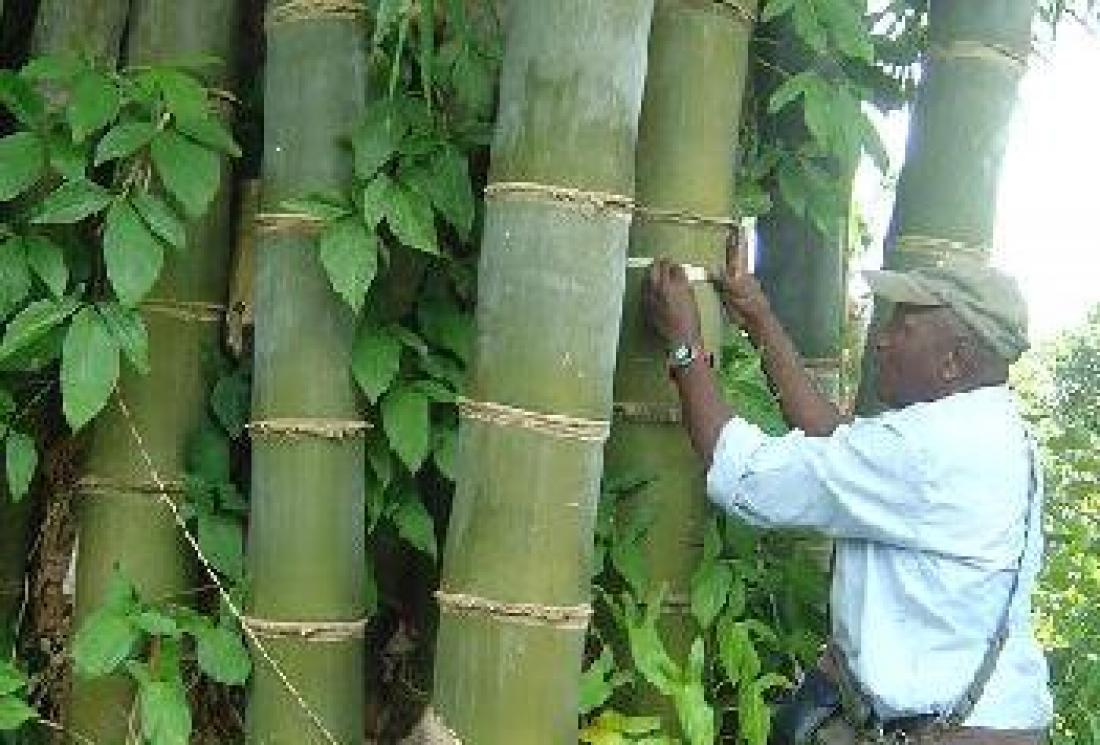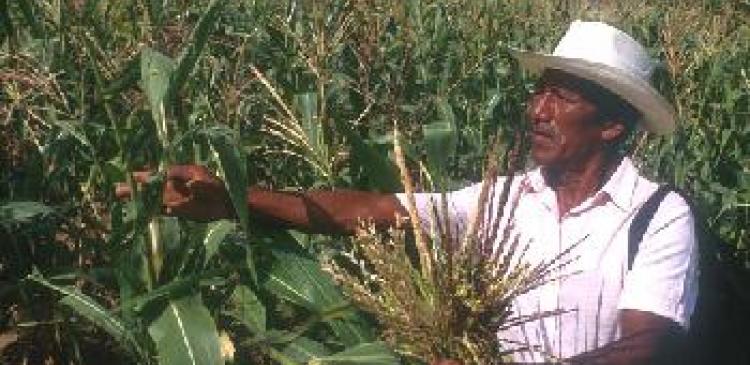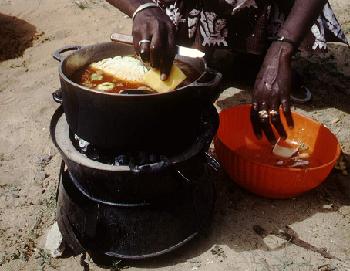RESILIENT BAMBOO AND RATTAN ANCHOR ENVIRONMENTAL REVIVAL
Bamboo and rattan are at the centre of major initiatives in Asia, Africa, and Latin America that are combatting global warming, fighting soil erosion, protecting forests, and enhancing communities’ access to water.
When IDRC first supported pioneering research on these plants in 1979, the world knew little of their positive environmental potential. But this is changing thanks to work undertaken by the International Network for Bamboo and Rattan (INBAR), created by IDRC in the early 1990s as an extension of earlier IDRC-sponsored research.
In Allahabad, India, bamboo planting restored the fertility of soil degraded by brick mining, so farmers once again can grow crops. That project, which won the 2007 Alcan Prize for Sustainability, also raised the local water table by seven metres within five years.
A new bamboo plantation in China’s Guizhou province reduced soil erosion in a mountainous area by 75%, while making degraded farmland and forests viable again. Meanwhile, manufacturing charcoal from sustainable bamboo in India, Tanzania, Ghana, Ethiopia, Mozambique, and the Philippines has prevented the deforestation that results when trees are cut to make fuel.
New bamboo-based building techniques developed in Latin America and since transferred to Uganda and Kenya have similarly reduced reliance on threatened forests while avoiding the use of concrete, a major producer of carbon dioxide. How bamboo and rattan plantations can capture carbon dioxide already in the atmosphere is the subject of ongoing research.
Network based in Beijing
The first-ever international workshops on rattan and bamboo in 1979 and 1980, both held at IDRC’s Singapore office, blossomed soon after into the Bamboo and Rattan Research Network, the precursor to INBAR. Housed initially at IDRC, in 1997 INBAR became independent – and also the first international research organization to be based in Beijing. Since then, IDRC has supported INBAR’s work through a series of grants.
From the beginning, the researchers recognized the unique environmental role of these traditional Asian crops, which are “actually a palm (rattan) and a kind of big grass (bamboo),” INBAR director-general Coosje Hoogendoorn explains. “Like grass, you can cut bamboo and it will quickly grow back.”
Those grass-like qualities account for bamboo’s restorative roles within the environment. Bamboo has roots, for example, that remain in the ground after the poles are cut. Those resilient roots can prevent soil erosion, condition soil, and draw water closer to the surface in areas where the water table is low. Bamboo plants also absorb at least as much carbon dioxide as trees, providing a renewable buffer against global warming.
Income from incense
Another aspect of INBAR’s current approach that began within IDRC is the use of bamboo and rattan as a platform for practising “sustainable development.” Sustainable development means, essentially, that economic reward and environmental stewardship can be mutually reinforcing. And so, the research agenda for bamboo and rattan — which have numerous economic applications — has focused largely on finding ways for poor communities to add value to raw materials by creating finished products. This helps keep jobs and income in communities.
For example, one IDRC-supported INBAR project works with women in Tripura, India, who used to craft the raw bamboo sticks that were made into incense sticks elsewhere. Now, the women have taken over the rolling, scenting, packaging, and even marketing of the finished sticks.
“It has been possible for women with virtually no income to get a reasonable income that helps them take care of their families,” Hoogendoorn says. That, in turn, has provided added incentive to use pro-environmental materials — a win-win proposition, where economic success and environmental improvements are achieved together.
-------------------------------------------------------------------------------------------------
SECURING LAND RIGHTS DIFUSES CONFLICTS IN CAMBODIA
The hill people in Cambodia’s Ratanakiri province set a powerful precedent that has served as a model for the country’s land tenure laws. With IDRC support, they protected their livelihoods — under threat from logging and land-clearing — by establishing legal rights to their land and its resources.
In the early 1990s, the Cambodian government readily granted contracts to investors for rubber and palm oil plantations and logging. This unrestrained development endangered the region’s forests — the source of food, fuel, medicine, and other essentials for local communities.
A research team led by the regional United Nations Development Programme office explored ways to address these resource conflicts at the local level. Researchers worked with villagers to develop processes for creating detailed maps and plans for the region, showing its customary boundaries as well as rules of conservation and allocation of resources.
These efforts convinced the governor of Ratanakiri to recognize the hill people’s traditional use of the land. Developers in conflict with the villagers were forced to back down, setting an encouraging precedent.
“On the ground, the project showed that community planning can be a powerful tool in addressing outside pressure,” says IDRC Senior Program Specialist Hein Mallee.
The researchers also established the need to include provisions for communal land tenure in Cambodia’s new land law. The participatory planning process used in Ratanakiri served as a model for the nation.
“The research was instrumental in incorporating natural resource issues in Cambodia’s local planning processes,” Mallee says. “It helped put the issue of communal land tenure on the national policy agenda.”
-----------------------------------------------------------------------------------------
CERAMIC STOVE EASES STRAIN ON AFRICAN FORESTS
A cooking stove that has become popular in Kenya and neighbouring countries has taken pressure off Africa’s threatened forests by reducing the demand for wood and charcoal.
IDRC began supporting research that led to the marketing of the ceramic Jiko stove in the mid-1980s, amid growing concern about deforestation and desertification. Today, surveys show that 80% of households in urban Nairobi and Mombasa use the domestic version of the stove, reducing their fuel consumption by up to 50%, reports Kenyan energy expert Stephen Karekezi.
Developed by the Kenyan agency KENGO, the ceramic Jiko now “has become almost the standard stove in Kenya,” he says.
Karekezi, a former regional manager for KENGO and now director of the Energy, Environment and Development Network for Africa, adds that several thousand institutional-scale Jiko stoves have been distributed within Kenya. Large numbers have also been exported to Ethiopia, Rwanda, Tanzania, Uganda, and other countries.
The big institutional demand for firewood is one reason the larger stoves became a prime focus for IDRC in the 1980s, says former IDRC project officer Ron Ayling. “When you have a reasonably large school of 100 kids, they would go through quite a bit of wood cooking meals,” he says.
Karekezi agrees: “It’s clear that a major source of deforestation is the institutional use of wood. You can see trucks going to institutions with wood specifically cut down for that use.”
With a smaller combustion chamber and insulated sides that ensure less heat is wasted, the ceramic Jiko boosts the efficient use of wood. In homes, where charcoal is used, the greener technology also delivers an economic dividend. It allows poor families to use money otherwise spent on fuel toward the purchase of food.
"The key to the success of the Kenyan ceramic Jiko was that there was no attempt to create a new marketing system. Informal sector workers producing the traditional stoves were sent designs and convinced to switch to this stove, so it piggybacked on the existing manufacturing and marketing infrastructure. As more and more workers began producing these stoves, the price came down dramatically."
- Stephen Karekezi, Director, Energy, Environment and Development Network for Africa
--------------------------------------------------------------------------------------------
MAIZE GENE BANKS HELP FARMERS ADAPT TO NEW CHALLENGES
Small-scale farmers in Oaxaca, Mexico, whose farming traditions are threatened, now have access to more native corn varieties from across the region, allowing them to breed local strains more adaptable to environmental challenges. This has been made possible by new tools and incentives provided through an innovative IDRC-funded program.
The farmers use a multitude of maize (corn) varieties – landraces – that are “very well adapted to harsh environments and poor soils, and require very few investments,” explains former International Maize and Wheat Improvement Centre (CIMMYT) scientist Mauricio Bellon.
By the late 1990s, commercial hybrid varieties were being promoted, and some traditional landraces had been lost. If the trend continued, farmers might become dependent on new varieties requiring expensive pesticides, fertilizers, and irrigation. Having to buy hybrids from seed companies every year also threatened the farmers’ economic viability.
With IDRC support, CIMMYT and the Mexican natural resource agency INIFAP canvassed farmers and catalogued the attributes of preferred varieties. These varieties were then “frozen in time” in maize gene banks.
Farmers were then given access to landraces from these gene banks, allowing them to cross-breed new maize types that could adapt to changing environmental conditions. Farmers also benefited from new storage facilities, allowing them to save maize for sale in future years when prices were higher.
These incentives bolstered the farmers’ determination to preserve Oaxaca’s biodiversity. Says former IDRC project manager Daniel Buckles: “Today, people are still on the land, raising families, generating incomes, and managing the diversity that is there.”
"The varieties of maize that the farmers create are like lottery tickets. They provide you the chance of winning in the future when you don’t know what’s going to happen in the environment. That’s the value of this for the world: The farmers are generating the winning combinations that can adapt to changing climate and production conditions."
-Mauricio Bellon, former CIMMYT project manager
-------------------------------------------------------------------------------------------------





